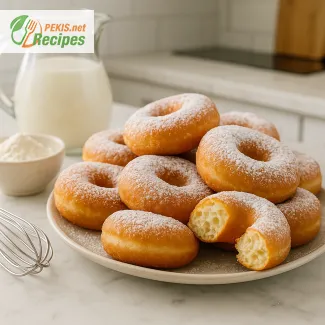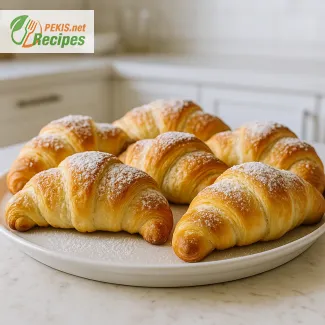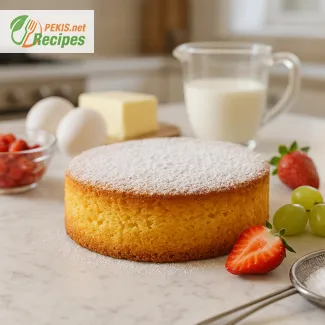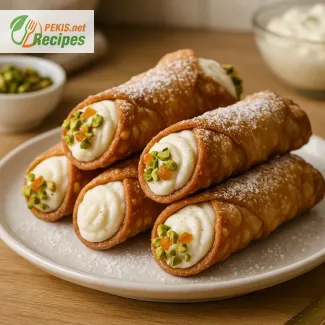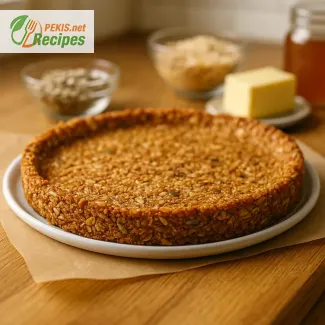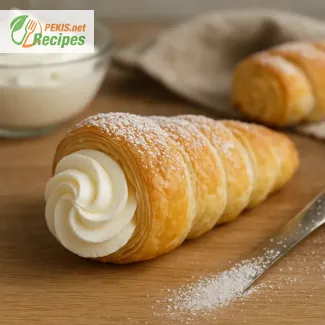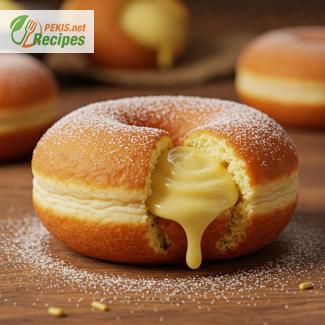
The Ultimate Pastry Cream for Donuts – A Rich and Velvety Delight
A Creamy Filling That Elevates Every Donut
There's something truly irresistible about a soft, pillowy donut filled with luscious, silky pastry cream. This decadent filling transforms an ordinary donut into an indulgent treat, bursting with rich vanilla flavor and a texture so smooth it melts in your mouth. Whether you're making classic Boston cream donuts, eclairs, or cream-filled pastries, mastering the art of perfect pastry cream will take your baking to the next level.
Pastry cream, or crème pâtissière, is a fundamental element in French pastry and is widely used to fill everything from profiteroles and tarts to Danish pastries and cream puffs. Made with milk, egg yolks, sugar, and a hint of vanilla, this velvety custard is thicker and richer than traditional pudding, making it the perfect complement to soft, fried donuts. The key to achieving the ideal consistency lies in properly tempering the eggs and ensuring a smooth, lump-free texture.
If you've ever bitten into a freshly fried donut and experienced the luxurious sensation of creamy filling oozing out, you know just how satisfying it can be. This homemade pastry cream offers a depth of flavor that store-bought fillings simply cannot match. By using quality ingredients and following a few essential techniques, you can achieve a pastry cream that is thick, smooth, and bursting with flavor.
What Makes This Pastry Cream the Best for Donuts?
Rich, Velvety Texture
Unlike whipped cream or custard, pastry cream has a rich, thick consistency that holds its shape while remaining creamy and smooth. The combination of egg yolks and cornstarch ensures the perfect balance between firmness and silkiness, making it easy to pipe into donuts without becoming runny.
Deep, Indulgent Flavor
The secret to an exceptional pastry cream lies in its ingredients. Using real vanilla bean or high-quality vanilla extract enhances the flavor, while a touch of butter gives it an extra luxurious mouthfeel. Unlike artificial fillings, this homemade cream is free from additives and delivers a truly authentic taste.
Versatile and Customizable
While the classic vanilla pastry cream is a timeless favorite, it can easily be customized with a variety of flavors. Add dark chocolate for a rich chocolate pastry cream, infuse it with espresso for a coffee twist, or mix in fruit purées for a fruity variation. The possibilities are endless, allowing you to personalize your donuts to suit any occasion.
The Secret to Perfectly Filled Donuts
Choosing the Right Donuts
For the best results, use light and fluffy yeast donuts rather than dense cake donuts. Yeast donuts have an airy interior that allows the pastry cream to spread evenly, creating a balanced bite of dough and filling.
Proper Filling Technique
Using a piping bag with a narrow tip, gently insert the nozzle into the side of the donut and fill it until you feel slight resistance. Avoid overfilling, as this can cause the donut to split. For an even distribution, fill from two opposite sides, ensuring that every bite is packed with creamy goodness.
Chilling for the Perfect Consistency
Once prepared, allow the pastry cream to cool completely before piping. Chilling it for at least two hours ensures that it thickens properly, making it easier to work with.
When to Use Pastry Cream in Donuts
This versatile filling is ideal for a variety of donut styles:
- Classic Cream-Filled Donuts – The most traditional way to enjoy pastry cream in donuts.
- Boston Cream Donuts – A donut variation of the Boston Cream Pie, featuring pastry cream filling and a chocolate glaze.
- Eclairs & Choux Pastries – While not technically donuts, these pastries also rely on smooth pastry cream for their signature texture.
- Fruity Pastry Cream Variations – Enhance the filling with lemon, raspberry, or coconut for a refreshing twist.
Elevate Your Baking with Homemade Pastry Cream
Creating homemade pastry cream may seem intimidating at first, but with a few simple steps, you can achieve a silky-smooth filling that rivals the best bakeries. By taking the time to cook the custard gently, whisk continuously, and strain for extra smoothness, you'll have a restaurant-quality filling that transforms your donuts into something truly special.
Once you master this essential pastry skill, you'll find endless ways to incorporate it into your dessert repertoire. Whether you're baking for a special occasion or simply indulging in a weekend treat, this perfect pastry cream for donuts will ensure that every bite is a decadent, creamy delight.
- Heat the milk: In a medium saucepan, heat the milk over medium heat until it starts to steam but does not boil. If using a vanilla bean pod, split it lengthwise, scrape out the seeds, and add both the seeds and the pod to the milk. Let it infuse for 5 minutes, then remove the pod.
- Mix egg yolks and sugar: In a separate bowl, whisk together the egg yolks and sugar until the mixture becomes pale and slightly thick.
- Add cornstarch: Sift in the cornstarch and mix until smooth and fully incorporated.
- Temper the eggs: Slowly pour about ⅓ of the warm milk into the egg mixture, whisking continuously to prevent the eggs from curdling. Gradually add the rest of the milk while stirring constantly.
- Cook the pastry cream: Pour the mixture back into the saucepan and heat over medium-low heat, stirring constantly with a whisk or wooden spoon. Continue stirring until the mixture thickens and begins to bubble (about 3–5 minutes).
- Add butter and strain: Remove from heat and stir in the butter until fully melted. If the mixture has any lumps, strain it through a fine-mesh sieve for a silky smooth consistency.
- Cool the pastry cream: Transfer the pastry cream to a bowl, press a piece of plastic wrap directly onto the surface to prevent a skin from forming, and refrigerate for at least 2 hours before using.
- Filling the donuts: Once the pastry cream is chilled, transfer it into a piping bag with a narrow tip. Insert the tip into the side of each donut and gently squeeze until filled.
Elevating Your Pastry Cream for Donuts – Tips for a Superior Recipe
Small Changes, Big Improvements
A perfect pastry cream can transform your homemade donuts from simply good to truly exceptional. While the classic recipe delivers a deliciously smooth and creamy filling, small adjustments can enhance flavor, texture, and stability. Whether you want a richer consistency, a healthier alternative, or a more complex flavor profile, there are several ways to take this recipe to the next level.
Enhancing Flavor with Additional Ingredients
Infusing the Milk for a Deeper Taste
One of the simplest ways to intensify the flavor of your pastry cream is by infusing the milk with natural ingredients. While vanilla extract or vanilla beans provide a classic aroma, you can experiment with:
- Citrus zest (lemon or orange) – Adds a light, fresh contrast to the sweetness.
- Cinnamon sticks or nutmeg – Enhances the warmth of the filling, especially for fall or winter treats.
- Lavender or rose water – Introduces floral notes for a more refined and unique taste.
- Coffee or espresso powder – Gives depth, perfect for pairing with chocolate glazes.
Simply steep these ingredients in the warm milk before straining and proceeding with the recipe.
Using Different Sweeteners
The type of sugar used in pastry cream affects both taste and texture. While granulated sugar is the most common choice, alternatives can modify the final product:
- Brown sugar – Introduces caramel-like undertones and a slightly richer taste.
- Honey or maple syrup – Adds a deeper, more complex sweetness with natural flavors.
- Coconut sugar – A healthier, low-glycemic alternative that enhances the depth of flavor.
When using liquid sweeteners, slightly reduce the amount of milk to maintain the proper consistency.
Achieving the Perfect Texture
Controlling Thickness with Starch Variations
While cornstarch is the traditional thickener, different starches can yield slightly varied textures:
- Flour – Creates a slightly denser, more traditional custard.
- Tapioca starch – Produces an ultra-smooth and glossy texture.
- Potato starch – Offers a silkier, more delicate consistency.
Adjust the quantity slightly, as some starches absorb more liquid than others.
Balancing Richness with Dairy Choices
For a creamier and more indulgent pastry cream, consider modifying the milk-to-cream ratio:
- Replace half of the milk with heavy cream – Increases richness and smoothness.
- Use evaporated milk – Results in a slightly caramelized and concentrated taste.
- Substitute with coconut milk – A dairy-free option that adds a slight nutty sweetness.
Reducing the fat content (by using skim or almond milk) will create a lighter pastry cream but may compromise its silky texture.
Why Homemade Pastry Cream Is Better
Making pastry cream from scratch offers significant advantages over store-bought alternatives.
- No Artificial Preservatives – Commercial pastry creams often contain stabilizers and artificial thickeners that alter the natural taste and texture.
- Customizable Flavors – You can adjust sweetness, richness, and taste to your preference.
- Better Nutritional Control – You can reduce sugar content, use natural thickeners, or opt for organic ingredients.
- Superior Freshness – Freshly made pastry cream has a brighter flavor compared to pre-packaged versions that may sit on store shelves for months.
Common Mistakes to Avoid
Overcooking the Mixture
Cooking the pastry cream at too high a temperature can cause the eggs to curdle, leading to a grainy texture. To avoid this:
- Cook over medium-low heat, stirring constantly.
- If lumps form, strain the mixture immediately through a sieve.
Not Tempering the Eggs Properly
Adding hot milk too quickly to the egg mixture can result in scrambled eggs. Always gradually pour and whisk continuously to ensure smooth incorporation.
Skipping the Plastic Wrap Trick
Pastry cream develops a skin if left uncovered while cooling. Always press plastic wrap directly onto the surface to prevent this.
Filling Donuts Too Soon
If the cream is too warm, it will be too runny to hold its shape inside the donuts. Always chill it completely before using.
Healthier Alternatives for a Lighter Pastry Cream
Lowering the Sugar Content
Reducing the sugar amount by 25–30% won't significantly affect the texture but will make the filling less sweet and more balanced. You can also use:
- Stevia or monk fruit sweetener – A zero-calorie substitute.
- Agave nectar – A natural alternative that adds a mild sweetness.
Dairy-Free and Vegan Variations
To create a plant-based pastry cream, substitute:
- Almond, oat, or coconut milk for whole milk.
- Coconut cream for heavy cream (if using).
- Cornstarch and extra plant-based milk for egg yolks (use 3 tbsp cornstarch per egg yolk).
Boosting Nutritional Value
To enhance the nutritional profile of your pastry cream, consider adding:
- Chia seeds (1 tsp ground) – Increases fiber and omega-3s.
- Protein powder (1 tbsp vanilla-flavored) – Adds extra protein.
- Greek yogurt (2 tbsp mixed in after cooling) – Introduces probiotics for gut health.
Improving This Classic Recipe
By making small but strategic changes, you can transform a traditional pastry cream into something truly special. Whether you're aiming for a richer texture, bolder flavors, or healthier adaptations, experimenting with different ingredients and techniques allows you to craft a pastry cream that perfectly suits your taste.
By avoiding common mistakes and understanding how each ingredient affects the final product, you can ensure that every batch of homemade pastry cream is smooth, flavorful, and absolutely irresistible.
- Eggs, milk (dairy), and possible gluten cross-contamination
- Gluten-free alternative: Use a certified gluten-free cornstarch
- Dairy-free alternative: Replace milk with almond or oat milk and butter with dairy-free margarine
- Egg-free alternative: Substitute egg yolks with 2 tbsp cornstarch and 50 ml additional milk
- Calcium (110 mg per serving) – Essential for bone health and muscle function. Source: EFSA
- Vitamin B2 (0.2 mg per serving) – Helps convert food into energy. Source: NIH
- Iron (0.5 mg per serving) – Supports oxygen transport in blood. Source: USDA
- Vanilla extract (contains vanillin, 1-2 mg per serving) – Provides anti-inflammatory and neuroprotective effects. Source: EFSA
- Egg yolks (contain lutein and zeaxanthin, 0.3 mg per serving) – Support eye health and reduce oxidative stress. Source: NIH
